TSOM6066 Coursework: Airline Industry Analysis and Service Quality
VerifiedAdded on 2022/11/18
|24
|5471
|225
Report
AI Summary
This report examines the airline industry, focusing on Turkish and Norwegian Airlines, exploring strategies to enhance employee performance and job satisfaction. It delves into the service concepts, target markets, and corporate strategies of both airlines, followed by a comparative value chain analysis. The report also provides recommendations for measuring service quality and customer satisfaction, covering various methods such as SERVQUAL, surveys, and social media monitoring. The analysis includes discussions on inbound and outbound logistics, marketing, sales, and service aspects, offering a comprehensive overview of the airlines' operations and customer engagement approaches. The report aims to identify the issues the airline industry faces with customers and how the industry manages its quality in a competitive market.
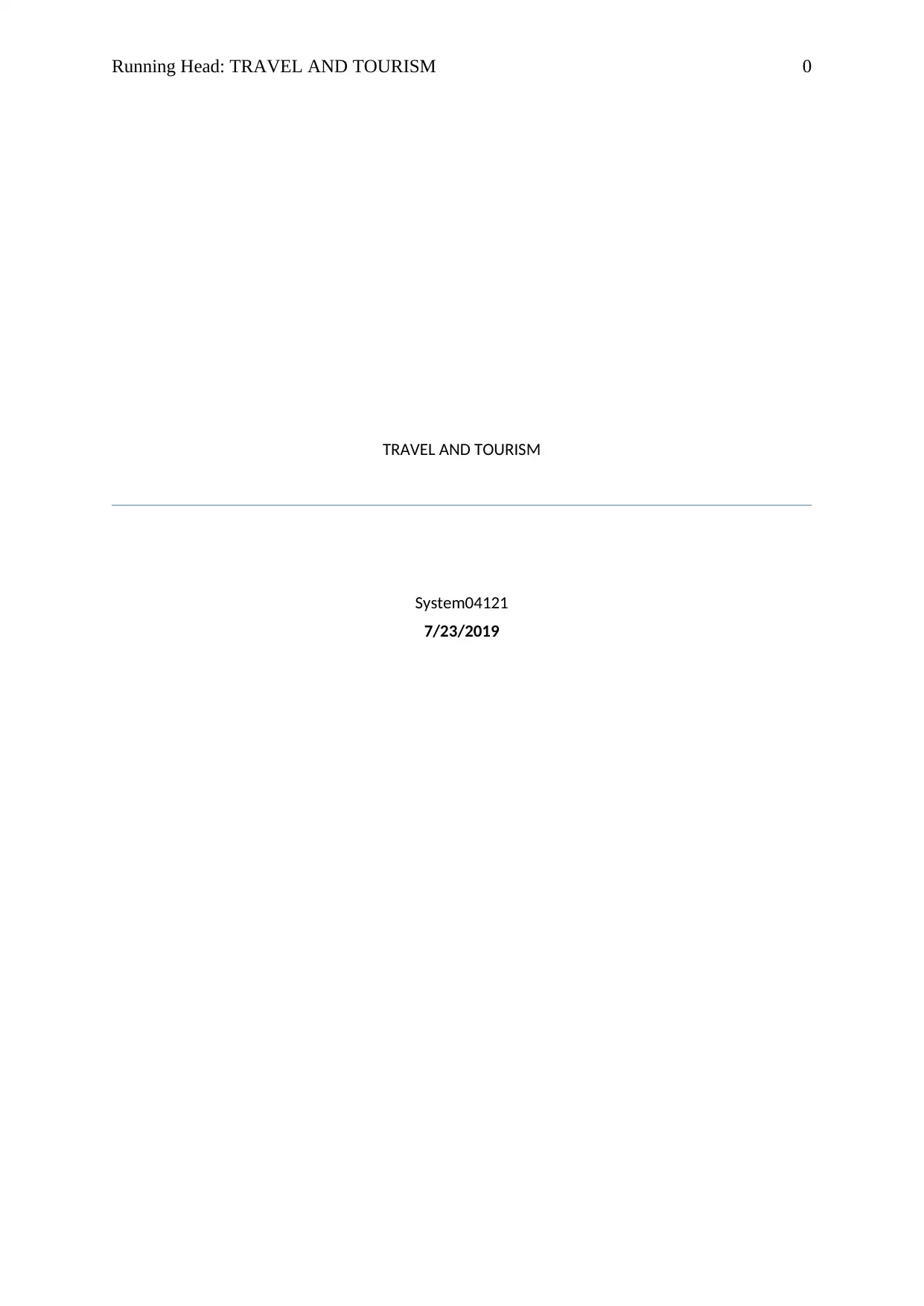
Running Head: TRAVEL AND TOURISM 0
TRAVEL AND TOURISM
System04121
7/23/2019
TRAVEL AND TOURISM
System04121
7/23/2019
Paraphrase This Document
Need a fresh take? Get an instant paraphrase of this document with our AI Paraphraser
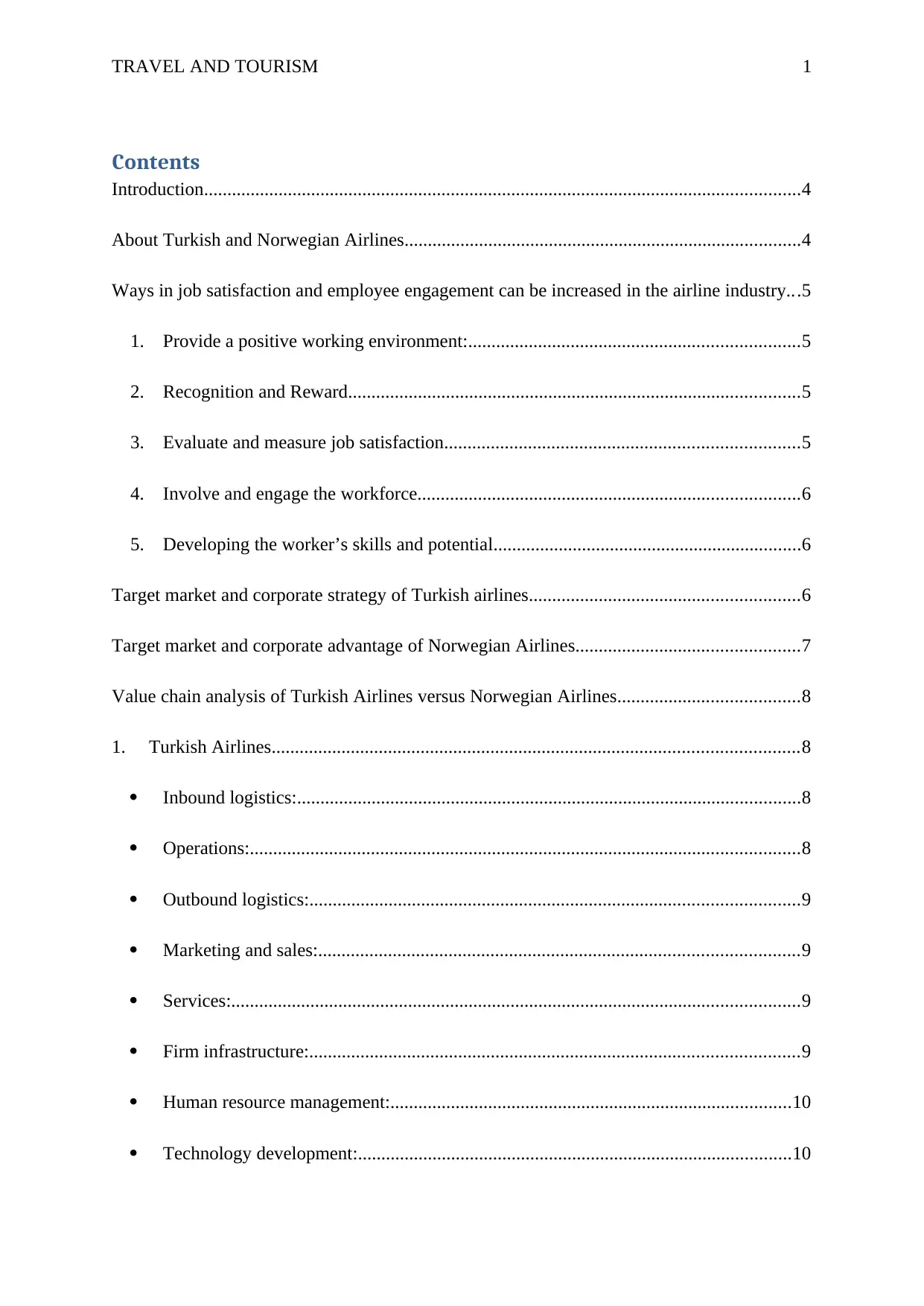
TRAVEL AND TOURISM 1
Contents
Introduction................................................................................................................................4
About Turkish and Norwegian Airlines.....................................................................................4
Ways in job satisfaction and employee engagement can be increased in the airline industry...5
1. Provide a positive working environment:.......................................................................5
2. Recognition and Reward.................................................................................................5
3. Evaluate and measure job satisfaction............................................................................5
4. Involve and engage the workforce..................................................................................6
5. Developing the worker’s skills and potential..................................................................6
Target market and corporate strategy of Turkish airlines..........................................................6
Target market and corporate advantage of Norwegian Airlines................................................7
Value chain analysis of Turkish Airlines versus Norwegian Airlines.......................................8
1. Turkish Airlines.................................................................................................................8
Inbound logistics:............................................................................................................8
Operations:......................................................................................................................8
Outbound logistics:.........................................................................................................9
Marketing and sales:.......................................................................................................9
Services:..........................................................................................................................9
Firm infrastructure:.........................................................................................................9
Human resource management:......................................................................................10
Technology development:.............................................................................................10
Contents
Introduction................................................................................................................................4
About Turkish and Norwegian Airlines.....................................................................................4
Ways in job satisfaction and employee engagement can be increased in the airline industry...5
1. Provide a positive working environment:.......................................................................5
2. Recognition and Reward.................................................................................................5
3. Evaluate and measure job satisfaction............................................................................5
4. Involve and engage the workforce..................................................................................6
5. Developing the worker’s skills and potential..................................................................6
Target market and corporate strategy of Turkish airlines..........................................................6
Target market and corporate advantage of Norwegian Airlines................................................7
Value chain analysis of Turkish Airlines versus Norwegian Airlines.......................................8
1. Turkish Airlines.................................................................................................................8
Inbound logistics:............................................................................................................8
Operations:......................................................................................................................8
Outbound logistics:.........................................................................................................9
Marketing and sales:.......................................................................................................9
Services:..........................................................................................................................9
Firm infrastructure:.........................................................................................................9
Human resource management:......................................................................................10
Technology development:.............................................................................................10
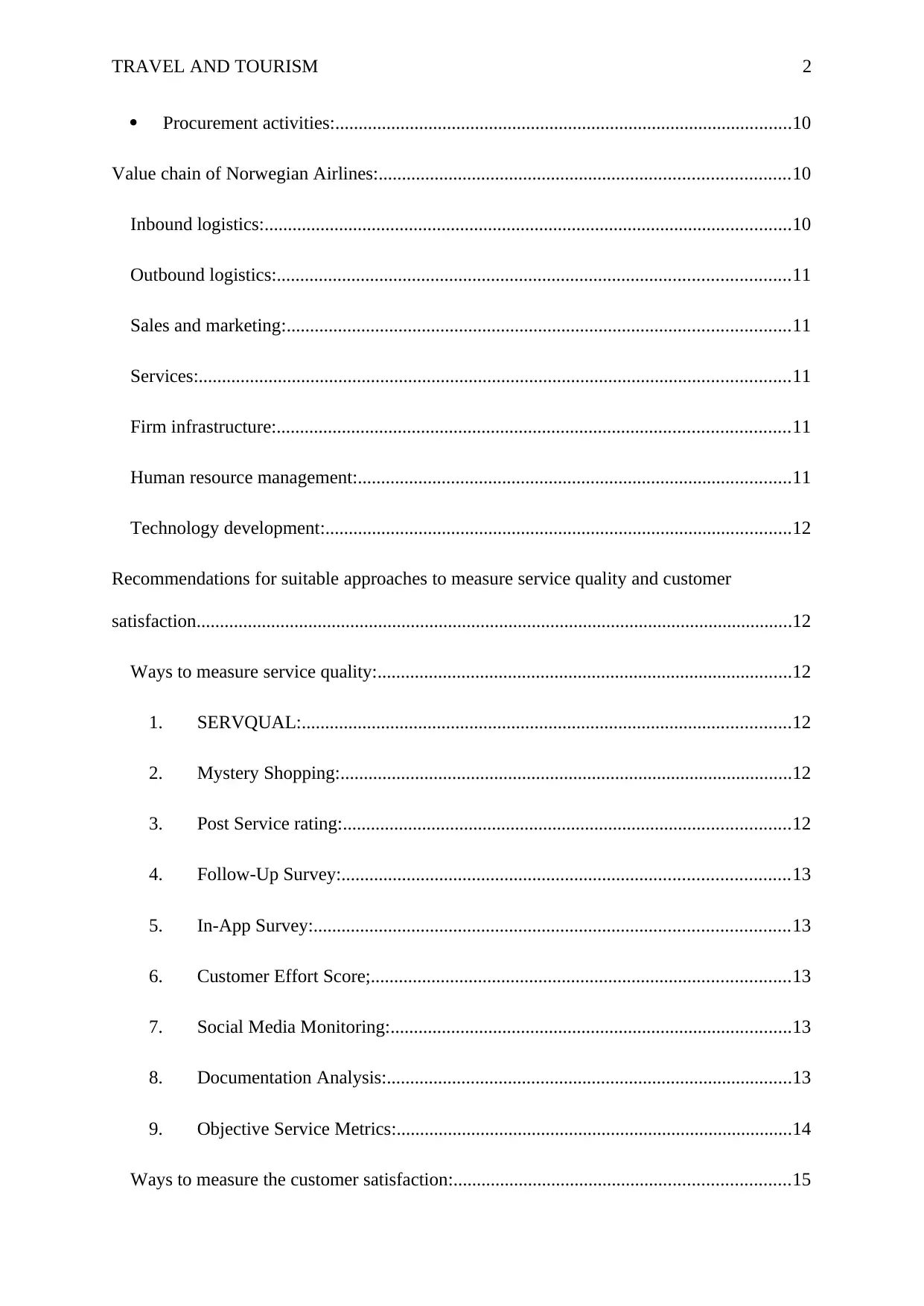
TRAVEL AND TOURISM 2
Procurement activities:..................................................................................................10
Value chain of Norwegian Airlines:........................................................................................10
Inbound logistics:.................................................................................................................10
Outbound logistics:..............................................................................................................11
Sales and marketing:............................................................................................................11
Services:...............................................................................................................................11
Firm infrastructure:..............................................................................................................11
Human resource management:.............................................................................................11
Technology development:....................................................................................................12
Recommendations for suitable approaches to measure service quality and customer
satisfaction................................................................................................................................12
Ways to measure service quality:.........................................................................................12
1. SERVQUAL:.........................................................................................................12
2. Mystery Shopping:.................................................................................................12
3. Post Service rating:................................................................................................12
4. Follow-Up Survey:................................................................................................13
5. In-App Survey:......................................................................................................13
6. Customer Effort Score;..........................................................................................13
7. Social Media Monitoring:......................................................................................13
8. Documentation Analysis:.......................................................................................13
9. Objective Service Metrics:.....................................................................................14
Ways to measure the customer satisfaction:........................................................................15
Procurement activities:..................................................................................................10
Value chain of Norwegian Airlines:........................................................................................10
Inbound logistics:.................................................................................................................10
Outbound logistics:..............................................................................................................11
Sales and marketing:............................................................................................................11
Services:...............................................................................................................................11
Firm infrastructure:..............................................................................................................11
Human resource management:.............................................................................................11
Technology development:....................................................................................................12
Recommendations for suitable approaches to measure service quality and customer
satisfaction................................................................................................................................12
Ways to measure service quality:.........................................................................................12
1. SERVQUAL:.........................................................................................................12
2. Mystery Shopping:.................................................................................................12
3. Post Service rating:................................................................................................12
4. Follow-Up Survey:................................................................................................13
5. In-App Survey:......................................................................................................13
6. Customer Effort Score;..........................................................................................13
7. Social Media Monitoring:......................................................................................13
8. Documentation Analysis:.......................................................................................13
9. Objective Service Metrics:.....................................................................................14
Ways to measure the customer satisfaction:........................................................................15
⊘ This is a preview!⊘
Do you want full access?
Subscribe today to unlock all pages.

Trusted by 1+ million students worldwide
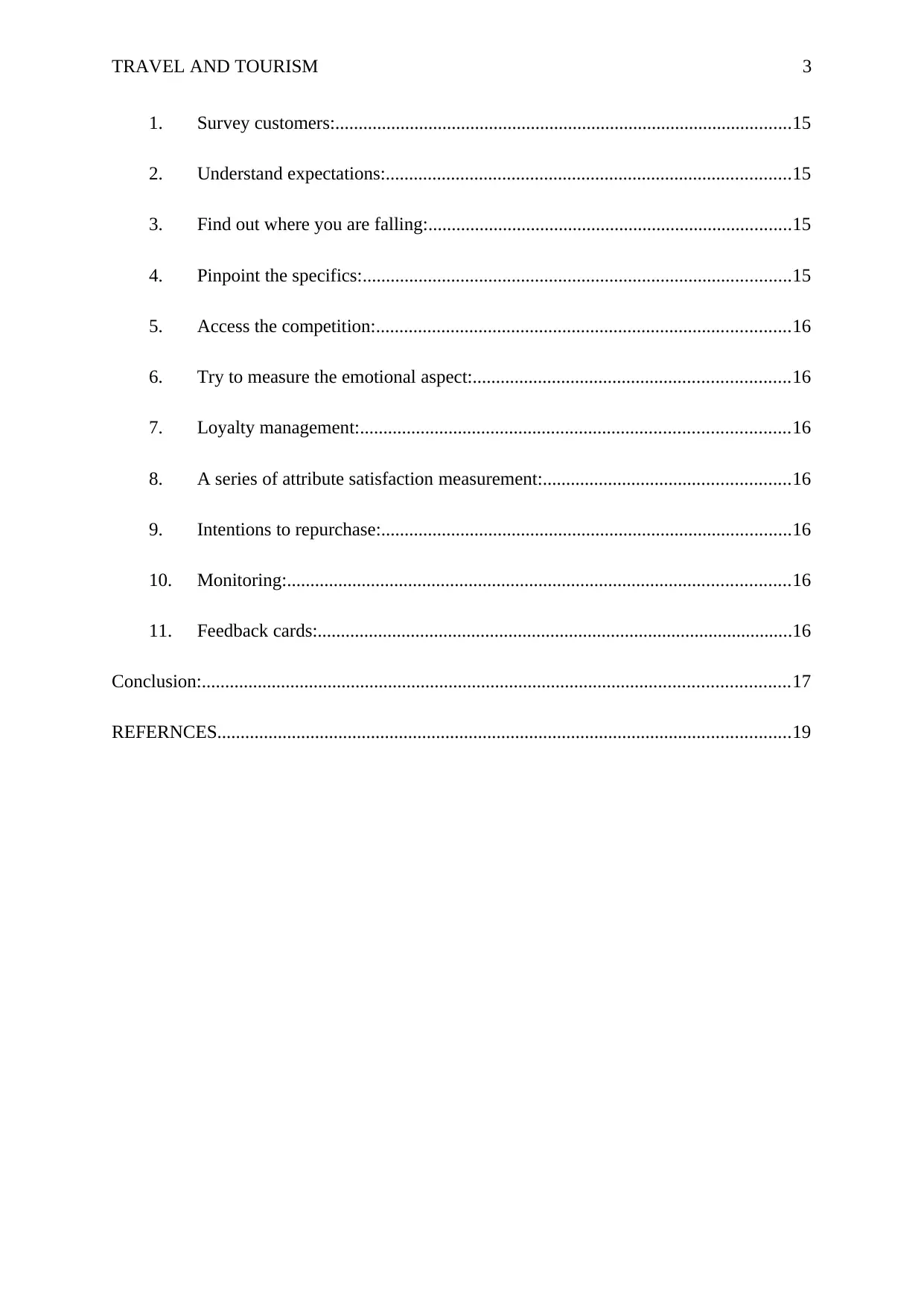
TRAVEL AND TOURISM 3
1. Survey customers:..................................................................................................15
2. Understand expectations:.......................................................................................15
3. Find out where you are falling:..............................................................................15
4. Pinpoint the specifics:............................................................................................15
5. Access the competition:.........................................................................................16
6. Try to measure the emotional aspect:....................................................................16
7. Loyalty management:............................................................................................16
8. A series of attribute satisfaction measurement:.....................................................16
9. Intentions to repurchase:........................................................................................16
10. Monitoring:............................................................................................................16
11. Feedback cards:......................................................................................................16
Conclusion:..............................................................................................................................17
REFERNCES...........................................................................................................................19
1. Survey customers:..................................................................................................15
2. Understand expectations:.......................................................................................15
3. Find out where you are falling:..............................................................................15
4. Pinpoint the specifics:............................................................................................15
5. Access the competition:.........................................................................................16
6. Try to measure the emotional aspect:....................................................................16
7. Loyalty management:............................................................................................16
8. A series of attribute satisfaction measurement:.....................................................16
9. Intentions to repurchase:........................................................................................16
10. Monitoring:............................................................................................................16
11. Feedback cards:......................................................................................................16
Conclusion:..............................................................................................................................17
REFERNCES...........................................................................................................................19
Paraphrase This Document
Need a fresh take? Get an instant paraphrase of this document with our AI Paraphraser
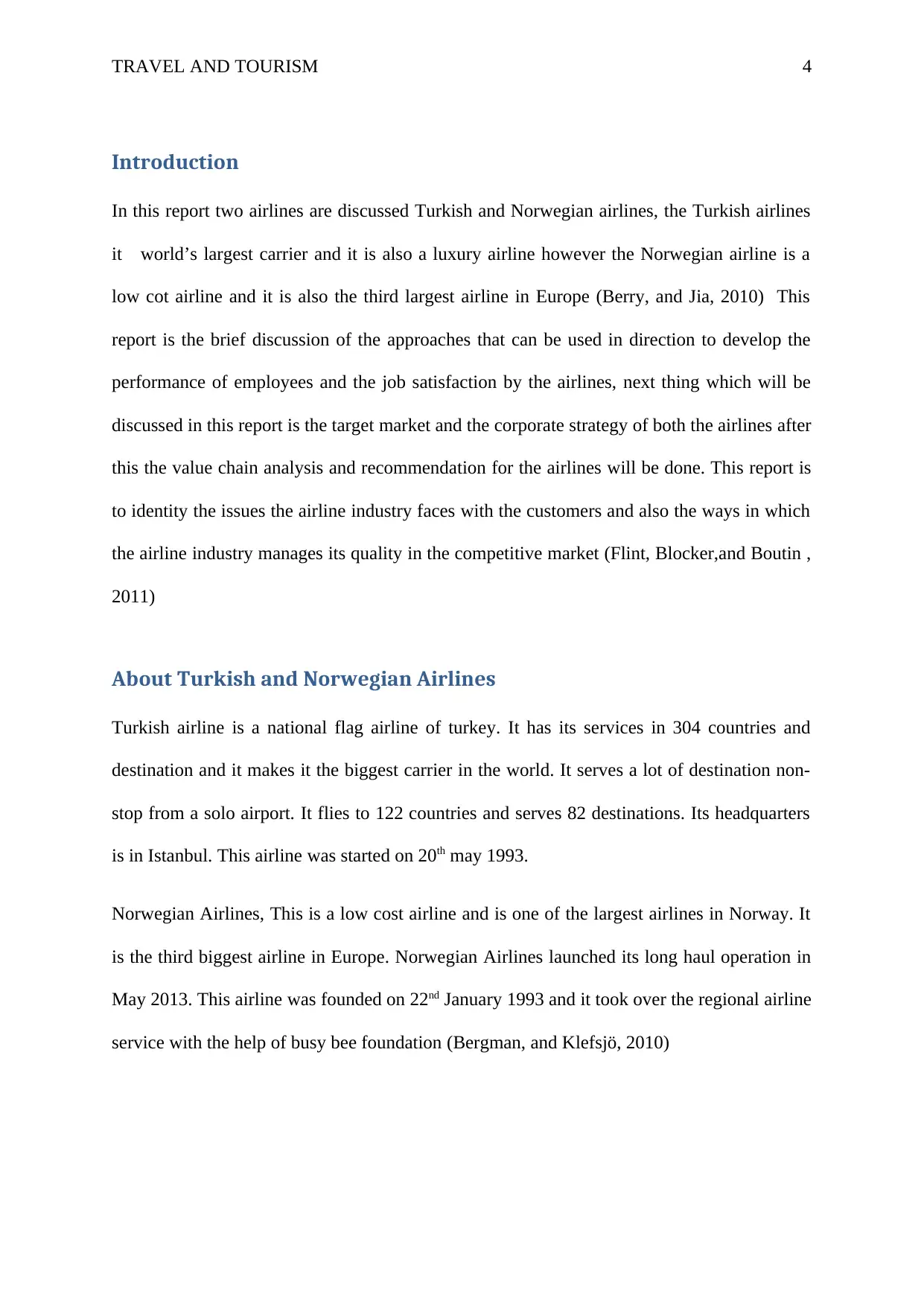
TRAVEL AND TOURISM 4
Introduction
In this report two airlines are discussed Turkish and Norwegian airlines, the Turkish airlines
it world’s largest carrier and it is also a luxury airline however the Norwegian airline is a
low cot airline and it is also the third largest airline in Europe (Berry, and Jia, 2010) This
report is the brief discussion of the approaches that can be used in direction to develop the
performance of employees and the job satisfaction by the airlines, next thing which will be
discussed in this report is the target market and the corporate strategy of both the airlines after
this the value chain analysis and recommendation for the airlines will be done. This report is
to identity the issues the airline industry faces with the customers and also the ways in which
the airline industry manages its quality in the competitive market (Flint, Blocker,and Boutin ,
2011)
About Turkish and Norwegian Airlines
Turkish airline is a national flag airline of turkey. It has its services in 304 countries and
destination and it makes it the biggest carrier in the world. It serves a lot of destination non-
stop from a solo airport. It flies to 122 countries and serves 82 destinations. Its headquarters
is in Istanbul. This airline was started on 20th may 1993.
Norwegian Airlines, This is a low cost airline and is one of the largest airlines in Norway. It
is the third biggest airline in Europe. Norwegian Airlines launched its long haul operation in
May 2013. This airline was founded on 22nd January 1993 and it took over the regional airline
service with the help of busy bee foundation (Bergman, and Klefsjö, 2010)
Introduction
In this report two airlines are discussed Turkish and Norwegian airlines, the Turkish airlines
it world’s largest carrier and it is also a luxury airline however the Norwegian airline is a
low cot airline and it is also the third largest airline in Europe (Berry, and Jia, 2010) This
report is the brief discussion of the approaches that can be used in direction to develop the
performance of employees and the job satisfaction by the airlines, next thing which will be
discussed in this report is the target market and the corporate strategy of both the airlines after
this the value chain analysis and recommendation for the airlines will be done. This report is
to identity the issues the airline industry faces with the customers and also the ways in which
the airline industry manages its quality in the competitive market (Flint, Blocker,and Boutin ,
2011)
About Turkish and Norwegian Airlines
Turkish airline is a national flag airline of turkey. It has its services in 304 countries and
destination and it makes it the biggest carrier in the world. It serves a lot of destination non-
stop from a solo airport. It flies to 122 countries and serves 82 destinations. Its headquarters
is in Istanbul. This airline was started on 20th may 1993.
Norwegian Airlines, This is a low cost airline and is one of the largest airlines in Norway. It
is the third biggest airline in Europe. Norwegian Airlines launched its long haul operation in
May 2013. This airline was founded on 22nd January 1993 and it took over the regional airline
service with the help of busy bee foundation (Bergman, and Klefsjö, 2010)
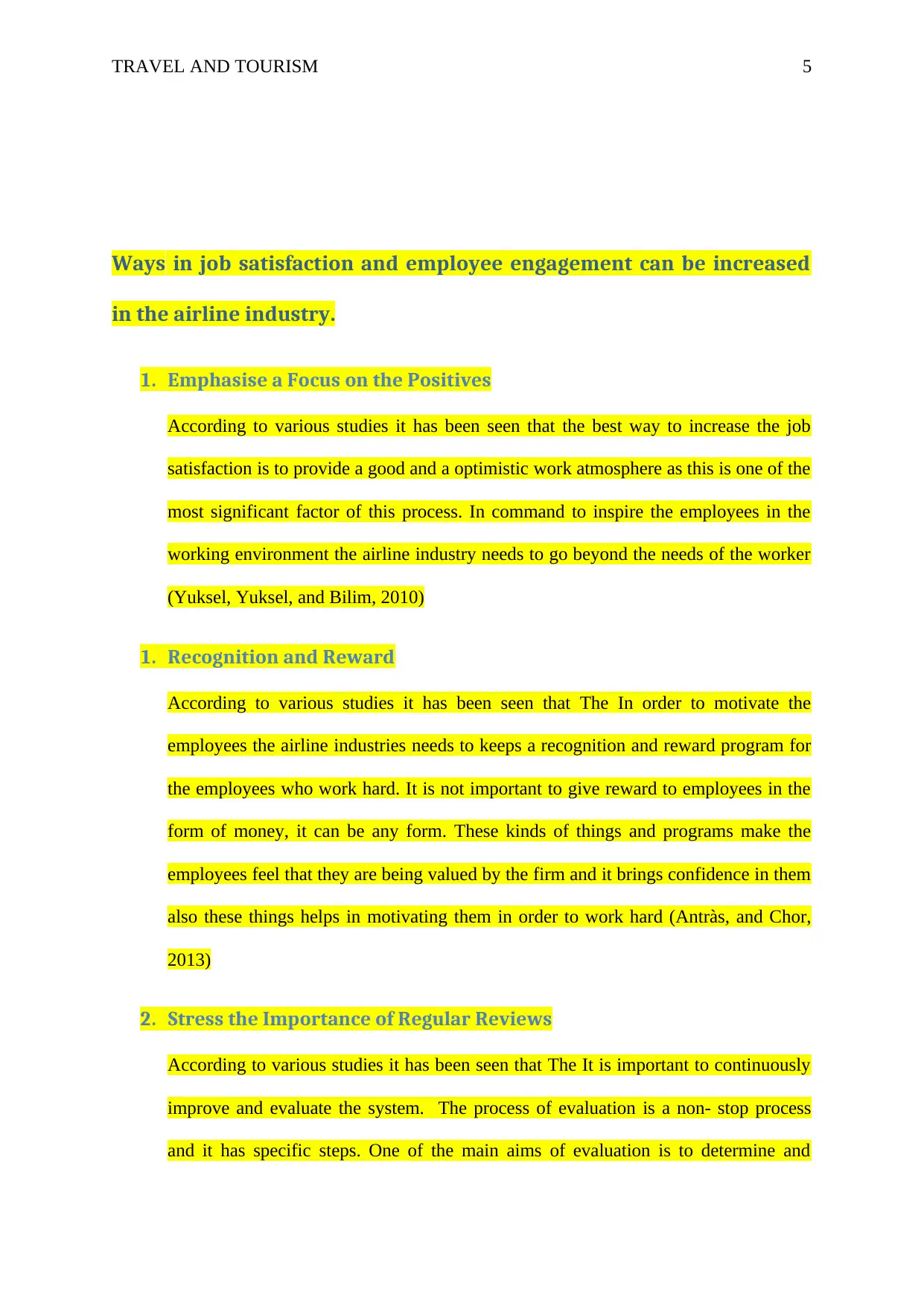
TRAVEL AND TOURISM 5
Ways in job satisfaction and employee engagement can be increased
in the airline industry.
1. Emphasise a Focus on the Positives
According to various studies it has been seen that the best way to increase the job
satisfaction is to provide a good and a optimistic work atmosphere as this is one of the
most significant factor of this process. In command to inspire the employees in the
working environment the airline industry needs to go beyond the needs of the worker
(Yuksel, Yuksel, and Bilim, 2010)
1. Recognition and Reward
According to various studies it has been seen that The In order to motivate the
employees the airline industries needs to keeps a recognition and reward program for
the employees who work hard. It is not important to give reward to employees in the
form of money, it can be any form. These kinds of things and programs make the
employees feel that they are being valued by the firm and it brings confidence in them
also these things helps in motivating them in order to work hard (Antràs, and Chor,
2013)
2. Stress the Importance of Regular Reviews
According to various studies it has been seen that The It is important to continuously
improve and evaluate the system. The process of evaluation is a non- stop process
and it has specific steps. One of the main aims of evaluation is to determine and
Ways in job satisfaction and employee engagement can be increased
in the airline industry.
1. Emphasise a Focus on the Positives
According to various studies it has been seen that the best way to increase the job
satisfaction is to provide a good and a optimistic work atmosphere as this is one of the
most significant factor of this process. In command to inspire the employees in the
working environment the airline industry needs to go beyond the needs of the worker
(Yuksel, Yuksel, and Bilim, 2010)
1. Recognition and Reward
According to various studies it has been seen that The In order to motivate the
employees the airline industries needs to keeps a recognition and reward program for
the employees who work hard. It is not important to give reward to employees in the
form of money, it can be any form. These kinds of things and programs make the
employees feel that they are being valued by the firm and it brings confidence in them
also these things helps in motivating them in order to work hard (Antràs, and Chor,
2013)
2. Stress the Importance of Regular Reviews
According to various studies it has been seen that The It is important to continuously
improve and evaluate the system. The process of evaluation is a non- stop process
and it has specific steps. One of the main aims of evaluation is to determine and
⊘ This is a preview!⊘
Do you want full access?
Subscribe today to unlock all pages.

Trusted by 1+ million students worldwide
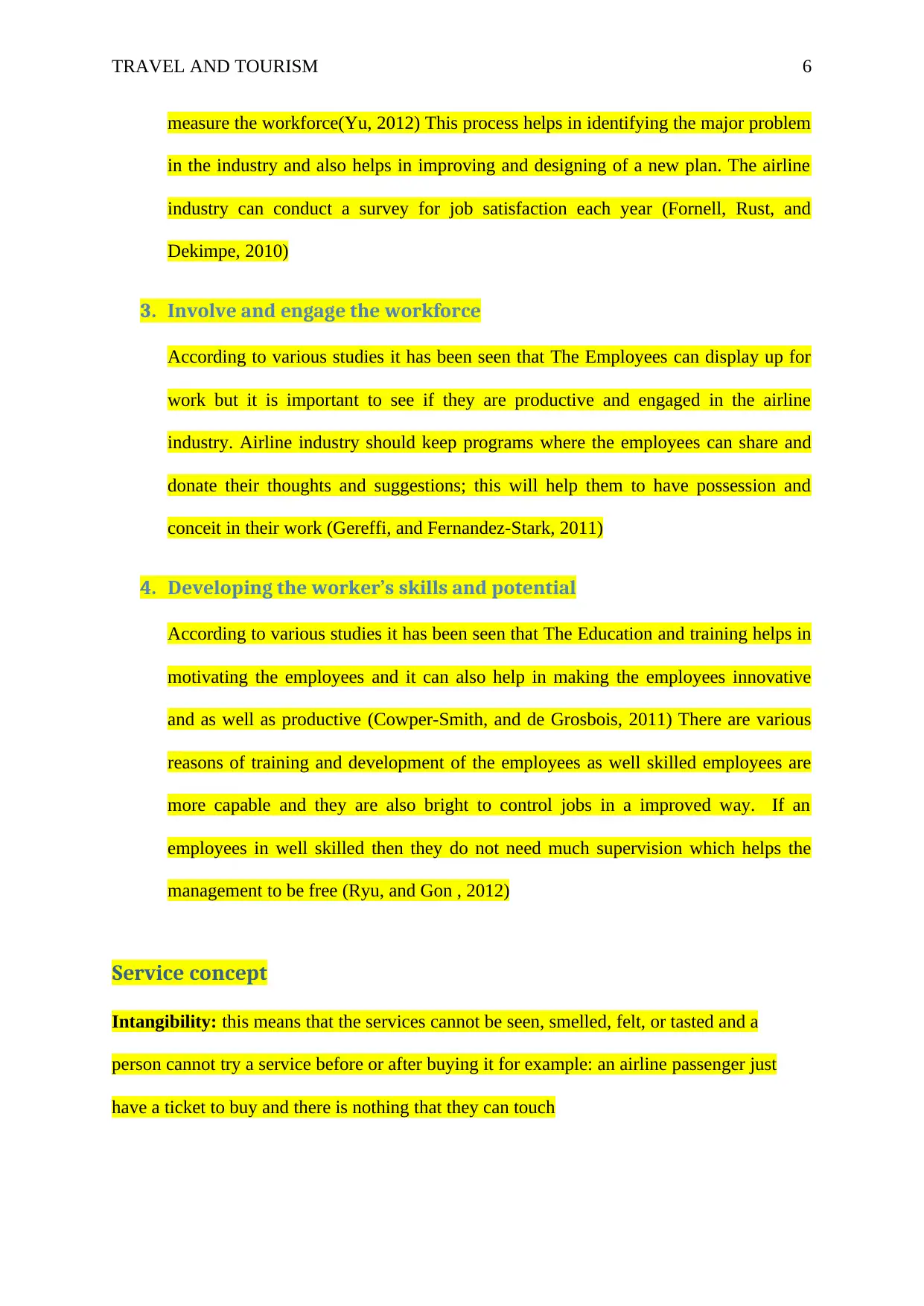
TRAVEL AND TOURISM 6
measure the workforce(Yu, 2012) This process helps in identifying the major problem
in the industry and also helps in improving and designing of a new plan. The airline
industry can conduct a survey for job satisfaction each year (Fornell, Rust, and
Dekimpe, 2010)
3. Involve and engage the workforce
According to various studies it has been seen that The Employees can display up for
work but it is important to see if they are productive and engaged in the airline
industry. Airline industry should keep programs where the employees can share and
donate their thoughts and suggestions; this will help them to have possession and
conceit in their work (Gereffi, and Fernandez-Stark, 2011)
4. Developing the worker’s skills and potential
According to various studies it has been seen that The Education and training helps in
motivating the employees and it can also help in making the employees innovative
and as well as productive (Cowper-Smith, and de Grosbois, 2011) There are various
reasons of training and development of the employees as well skilled employees are
more capable and they are also bright to control jobs in a improved way. If an
employees in well skilled then they do not need much supervision which helps the
management to be free (Ryu, and Gon , 2012)
Service concept
Intangibility: this means that the services cannot be seen, smelled, felt, or tasted and a
person cannot try a service before or after buying it for example: an airline passenger just
have a ticket to buy and there is nothing that they can touch
measure the workforce(Yu, 2012) This process helps in identifying the major problem
in the industry and also helps in improving and designing of a new plan. The airline
industry can conduct a survey for job satisfaction each year (Fornell, Rust, and
Dekimpe, 2010)
3. Involve and engage the workforce
According to various studies it has been seen that The Employees can display up for
work but it is important to see if they are productive and engaged in the airline
industry. Airline industry should keep programs where the employees can share and
donate their thoughts and suggestions; this will help them to have possession and
conceit in their work (Gereffi, and Fernandez-Stark, 2011)
4. Developing the worker’s skills and potential
According to various studies it has been seen that The Education and training helps in
motivating the employees and it can also help in making the employees innovative
and as well as productive (Cowper-Smith, and de Grosbois, 2011) There are various
reasons of training and development of the employees as well skilled employees are
more capable and they are also bright to control jobs in a improved way. If an
employees in well skilled then they do not need much supervision which helps the
management to be free (Ryu, and Gon , 2012)
Service concept
Intangibility: this means that the services cannot be seen, smelled, felt, or tasted and a
person cannot try a service before or after buying it for example: an airline passenger just
have a ticket to buy and there is nothing that they can touch
Paraphrase This Document
Need a fresh take? Get an instant paraphrase of this document with our AI Paraphraser
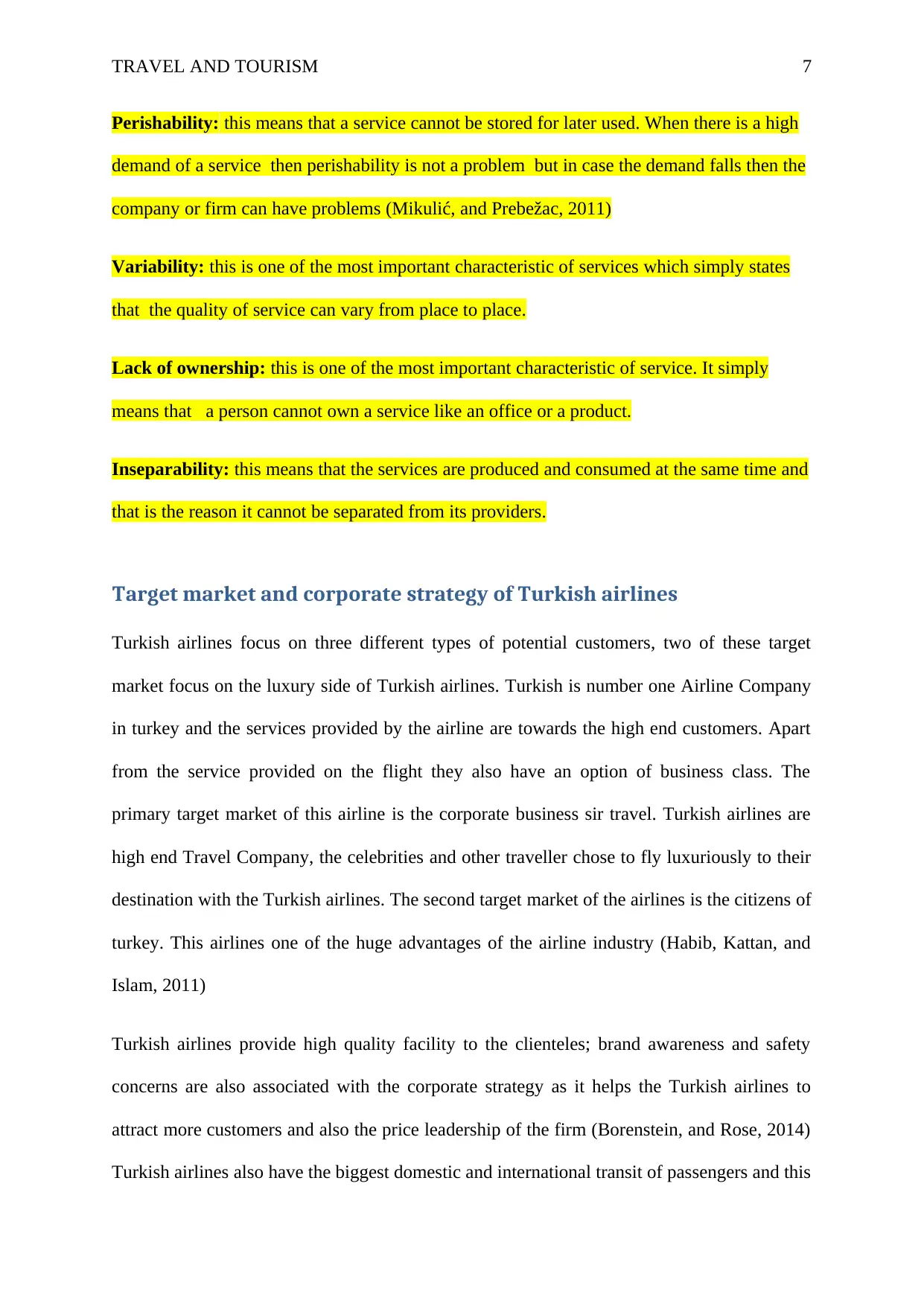
TRAVEL AND TOURISM 7
Perishability: this means that a service cannot be stored for later used. When there is a high
demand of a service then perishability is not a problem but in case the demand falls then the
company or firm can have problems (Mikulić, and Prebežac, 2011)
Variability: this is one of the most important characteristic of services which simply states
that the quality of service can vary from place to place.
Lack of ownership: this is one of the most important characteristic of service. It simply
means that a person cannot own a service like an office or a product.
Inseparability: this means that the services are produced and consumed at the same time and
that is the reason it cannot be separated from its providers.
Target market and corporate strategy of Turkish airlines
Turkish airlines focus on three different types of potential customers, two of these target
market focus on the luxury side of Turkish airlines. Turkish is number one Airline Company
in turkey and the services provided by the airline are towards the high end customers. Apart
from the service provided on the flight they also have an option of business class. The
primary target market of this airline is the corporate business sir travel. Turkish airlines are
high end Travel Company, the celebrities and other traveller chose to fly luxuriously to their
destination with the Turkish airlines. The second target market of the airlines is the citizens of
turkey. This airlines one of the huge advantages of the airline industry (Habib, Kattan, and
Islam, 2011)
Turkish airlines provide high quality facility to the clienteles; brand awareness and safety
concerns are also associated with the corporate strategy as it helps the Turkish airlines to
attract more customers and also the price leadership of the firm (Borenstein, and Rose, 2014)
Turkish airlines also have the biggest domestic and international transit of passengers and this
Perishability: this means that a service cannot be stored for later used. When there is a high
demand of a service then perishability is not a problem but in case the demand falls then the
company or firm can have problems (Mikulić, and Prebežac, 2011)
Variability: this is one of the most important characteristic of services which simply states
that the quality of service can vary from place to place.
Lack of ownership: this is one of the most important characteristic of service. It simply
means that a person cannot own a service like an office or a product.
Inseparability: this means that the services are produced and consumed at the same time and
that is the reason it cannot be separated from its providers.
Target market and corporate strategy of Turkish airlines
Turkish airlines focus on three different types of potential customers, two of these target
market focus on the luxury side of Turkish airlines. Turkish is number one Airline Company
in turkey and the services provided by the airline are towards the high end customers. Apart
from the service provided on the flight they also have an option of business class. The
primary target market of this airline is the corporate business sir travel. Turkish airlines are
high end Travel Company, the celebrities and other traveller chose to fly luxuriously to their
destination with the Turkish airlines. The second target market of the airlines is the citizens of
turkey. This airlines one of the huge advantages of the airline industry (Habib, Kattan, and
Islam, 2011)
Turkish airlines provide high quality facility to the clienteles; brand awareness and safety
concerns are also associated with the corporate strategy as it helps the Turkish airlines to
attract more customers and also the price leadership of the firm (Borenstein, and Rose, 2014)
Turkish airlines also have the biggest domestic and international transit of passengers and this
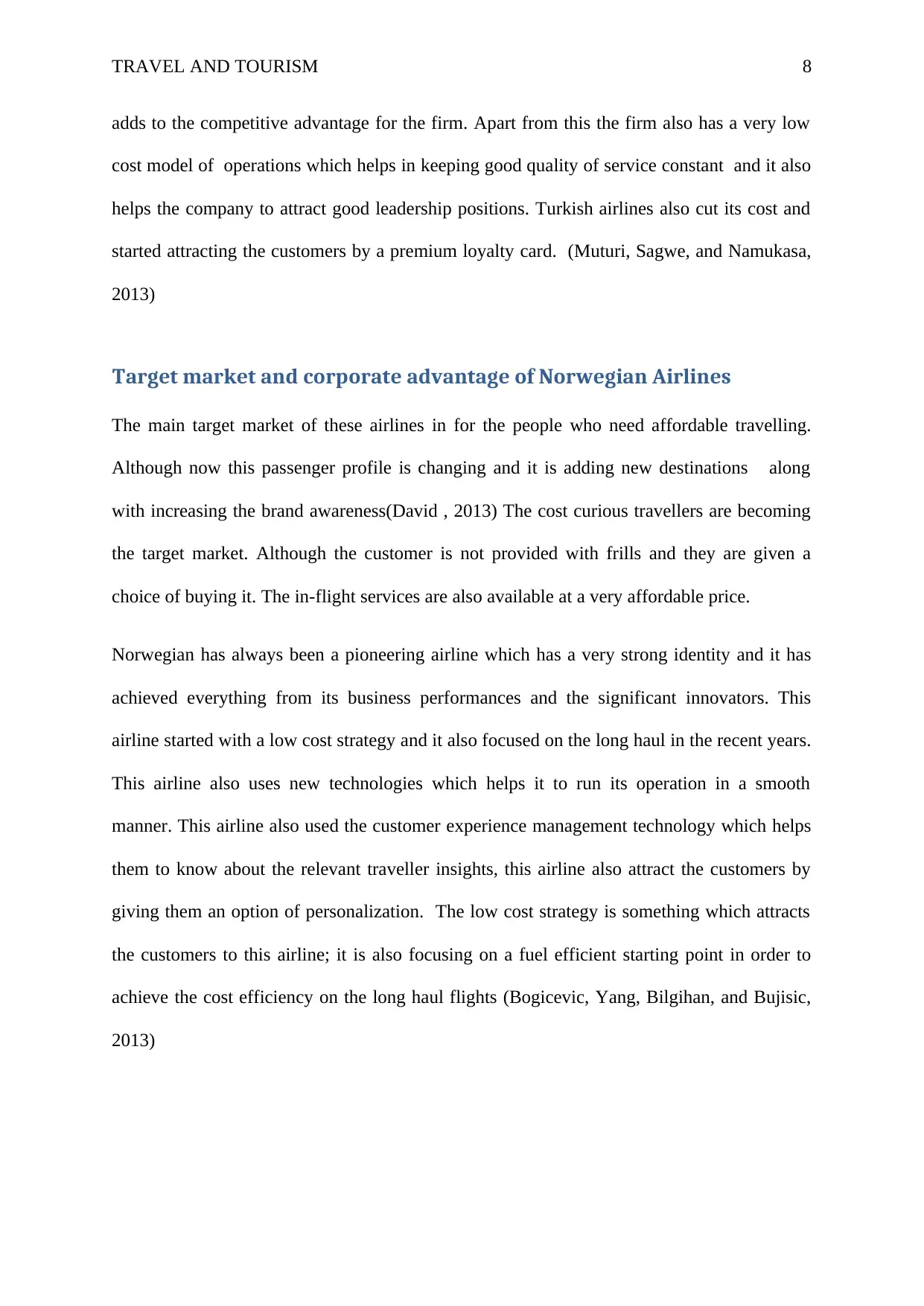
TRAVEL AND TOURISM 8
adds to the competitive advantage for the firm. Apart from this the firm also has a very low
cost model of operations which helps in keeping good quality of service constant and it also
helps the company to attract good leadership positions. Turkish airlines also cut its cost and
started attracting the customers by a premium loyalty card. (Muturi, Sagwe, and Namukasa,
2013)
Target market and corporate advantage of Norwegian Airlines
The main target market of these airlines in for the people who need affordable travelling.
Although now this passenger profile is changing and it is adding new destinations along
with increasing the brand awareness(David , 2013) The cost curious travellers are becoming
the target market. Although the customer is not provided with frills and they are given a
choice of buying it. The in-flight services are also available at a very affordable price.
Norwegian has always been a pioneering airline which has a very strong identity and it has
achieved everything from its business performances and the significant innovators. This
airline started with a low cost strategy and it also focused on the long haul in the recent years.
This airline also uses new technologies which helps it to run its operation in a smooth
manner. This airline also used the customer experience management technology which helps
them to know about the relevant traveller insights, this airline also attract the customers by
giving them an option of personalization. The low cost strategy is something which attracts
the customers to this airline; it is also focusing on a fuel efficient starting point in order to
achieve the cost efficiency on the long haul flights (Bogicevic, Yang, Bilgihan, and Bujisic,
2013)
adds to the competitive advantage for the firm. Apart from this the firm also has a very low
cost model of operations which helps in keeping good quality of service constant and it also
helps the company to attract good leadership positions. Turkish airlines also cut its cost and
started attracting the customers by a premium loyalty card. (Muturi, Sagwe, and Namukasa,
2013)
Target market and corporate advantage of Norwegian Airlines
The main target market of these airlines in for the people who need affordable travelling.
Although now this passenger profile is changing and it is adding new destinations along
with increasing the brand awareness(David , 2013) The cost curious travellers are becoming
the target market. Although the customer is not provided with frills and they are given a
choice of buying it. The in-flight services are also available at a very affordable price.
Norwegian has always been a pioneering airline which has a very strong identity and it has
achieved everything from its business performances and the significant innovators. This
airline started with a low cost strategy and it also focused on the long haul in the recent years.
This airline also uses new technologies which helps it to run its operation in a smooth
manner. This airline also used the customer experience management technology which helps
them to know about the relevant traveller insights, this airline also attract the customers by
giving them an option of personalization. The low cost strategy is something which attracts
the customers to this airline; it is also focusing on a fuel efficient starting point in order to
achieve the cost efficiency on the long haul flights (Bogicevic, Yang, Bilgihan, and Bujisic,
2013)
⊘ This is a preview!⊘
Do you want full access?
Subscribe today to unlock all pages.

Trusted by 1+ million students worldwide
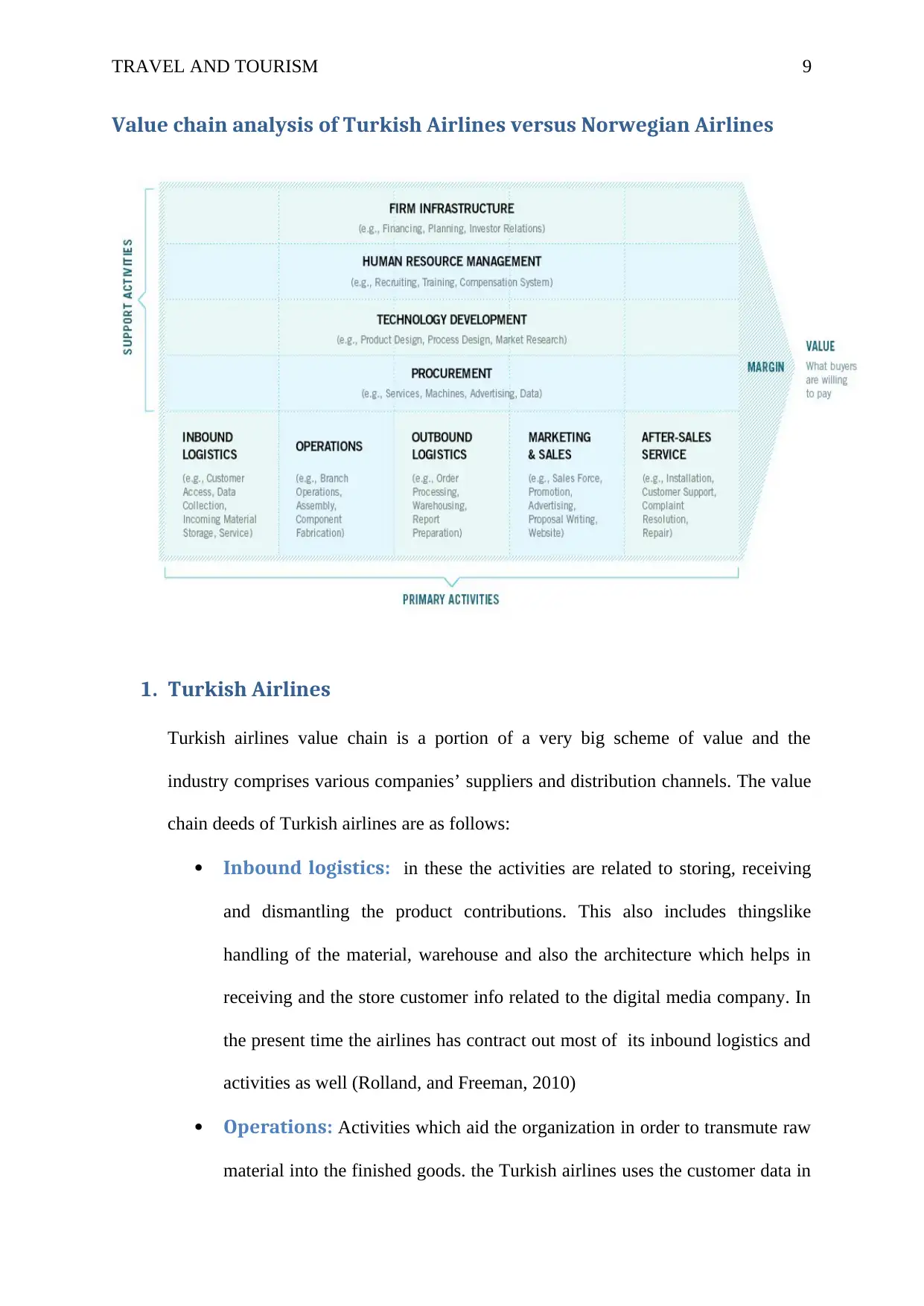
TRAVEL AND TOURISM 9
Value chain analysis of Turkish Airlines versus Norwegian Airlines
1. Turkish Airlines
Turkish airlines value chain is a portion of a very big scheme of value and the
industry comprises various companies’ suppliers and distribution channels. The value
chain deeds of Turkish airlines are as follows:
Inbound logistics: in these the activities are related to storing, receiving
and dismantling the product contributions. This also includes thingslike
handling of the material, warehouse and also the architecture which helps in
receiving and the store customer info related to the digital media company. In
the present time the airlines has contract out most of its inbound logistics and
activities as well (Rolland, and Freeman, 2010)
Operations: Activities which aid the organization in order to transmute raw
material into the finished goods. the Turkish airlines uses the customer data in
Value chain analysis of Turkish Airlines versus Norwegian Airlines
1. Turkish Airlines
Turkish airlines value chain is a portion of a very big scheme of value and the
industry comprises various companies’ suppliers and distribution channels. The value
chain deeds of Turkish airlines are as follows:
Inbound logistics: in these the activities are related to storing, receiving
and dismantling the product contributions. This also includes thingslike
handling of the material, warehouse and also the architecture which helps in
receiving and the store customer info related to the digital media company. In
the present time the airlines has contract out most of its inbound logistics and
activities as well (Rolland, and Freeman, 2010)
Operations: Activities which aid the organization in order to transmute raw
material into the finished goods. the Turkish airlines uses the customer data in
Paraphrase This Document
Need a fresh take? Get an instant paraphrase of this document with our AI Paraphraser
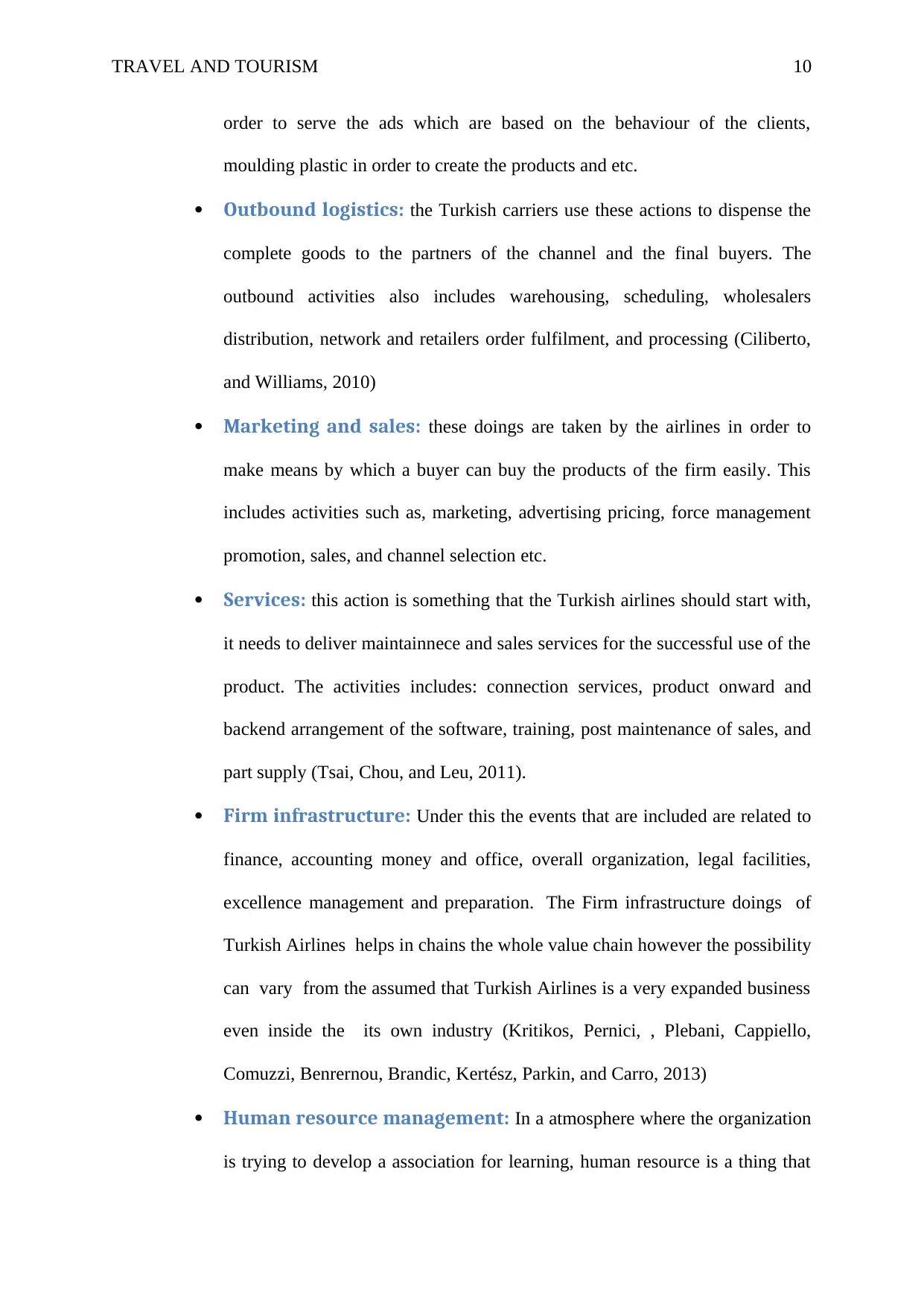
TRAVEL AND TOURISM 10
order to serve the ads which are based on the behaviour of the clients,
moulding plastic in order to create the products and etc.
Outbound logistics: the Turkish carriers use these actions to dispense the
complete goods to the partners of the channel and the final buyers. The
outbound activities also includes warehousing, scheduling, wholesalers
distribution, network and retailers order fulfilment, and processing (Ciliberto,
and Williams, 2010)
Marketing and sales: these doings are taken by the airlines in order to
make means by which a buyer can buy the products of the firm easily. This
includes activities such as, marketing, advertising pricing, force management
promotion, sales, and channel selection etc.
Services: this action is something that the Turkish airlines should start with,
it needs to deliver maintainnece and sales services for the successful use of the
product. The activities includes: connection services, product onward and
backend arrangement of the software, training, post maintenance of sales, and
part supply (Tsai, Chou, and Leu, 2011).
Firm infrastructure: Under this the events that are included are related to
finance, accounting money and office, overall organization, legal facilities,
excellence management and preparation. The Firm infrastructure doings of
Turkish Airlines helps in chains the whole value chain however the possibility
can vary from the assumed that Turkish Airlines is a very expanded business
even inside the its own industry (Kritikos, Pernici, , Plebani, Cappiello,
Comuzzi, Benrernou, Brandic, Kertész, Parkin, and Carro, 2013)
Human resource management: In a atmosphere where the organization
is trying to develop a association for learning, human resource is a thing that
order to serve the ads which are based on the behaviour of the clients,
moulding plastic in order to create the products and etc.
Outbound logistics: the Turkish carriers use these actions to dispense the
complete goods to the partners of the channel and the final buyers. The
outbound activities also includes warehousing, scheduling, wholesalers
distribution, network and retailers order fulfilment, and processing (Ciliberto,
and Williams, 2010)
Marketing and sales: these doings are taken by the airlines in order to
make means by which a buyer can buy the products of the firm easily. This
includes activities such as, marketing, advertising pricing, force management
promotion, sales, and channel selection etc.
Services: this action is something that the Turkish airlines should start with,
it needs to deliver maintainnece and sales services for the successful use of the
product. The activities includes: connection services, product onward and
backend arrangement of the software, training, post maintenance of sales, and
part supply (Tsai, Chou, and Leu, 2011).
Firm infrastructure: Under this the events that are included are related to
finance, accounting money and office, overall organization, legal facilities,
excellence management and preparation. The Firm infrastructure doings of
Turkish Airlines helps in chains the whole value chain however the possibility
can vary from the assumed that Turkish Airlines is a very expanded business
even inside the its own industry (Kritikos, Pernici, , Plebani, Cappiello,
Comuzzi, Benrernou, Brandic, Kertész, Parkin, and Carro, 2013)
Human resource management: In a atmosphere where the organization
is trying to develop a association for learning, human resource is a thing that
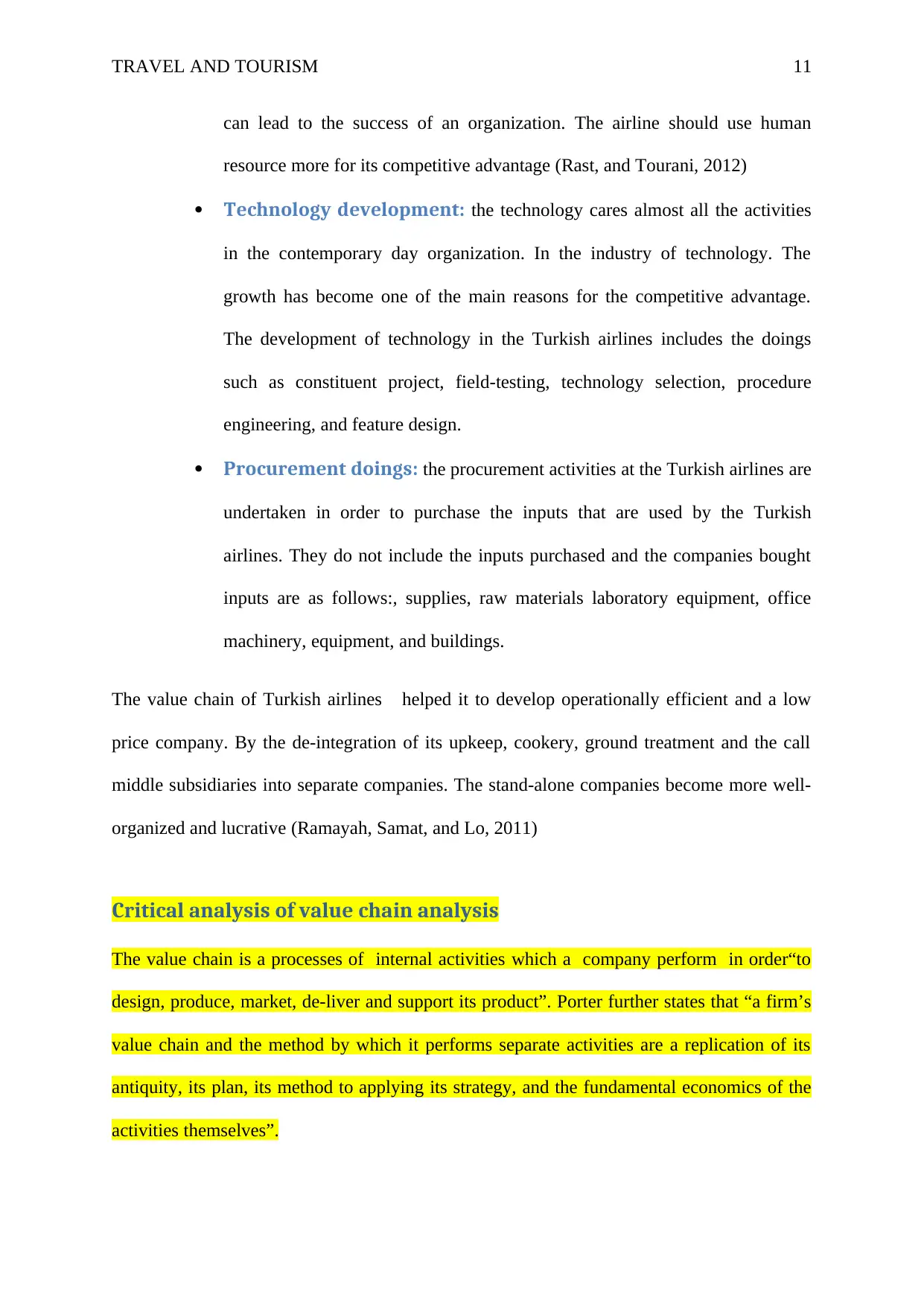
TRAVEL AND TOURISM 11
can lead to the success of an organization. The airline should use human
resource more for its competitive advantage (Rast, and Tourani, 2012)
Technology development: the technology cares almost all the activities
in the contemporary day organization. In the industry of technology. The
growth has become one of the main reasons for the competitive advantage.
The development of technology in the Turkish airlines includes the doings
such as constituent project, field-testing, technology selection, procedure
engineering, and feature design.
Procurement doings: the procurement activities at the Turkish airlines are
undertaken in order to purchase the inputs that are used by the Turkish
airlines. They do not include the inputs purchased and the companies bought
inputs are as follows:, supplies, raw materials laboratory equipment, office
machinery, equipment, and buildings.
The value chain of Turkish airlines helped it to develop operationally efficient and a low
price company. By the de-integration of its upkeep, cookery, ground treatment and the call
middle subsidiaries into separate companies. The stand-alone companies become more well-
organized and lucrative (Ramayah, Samat, and Lo, 2011)
Critical analysis of value chain analysis
The value chain is a processes of internal activities which a company perform in order“to
design, produce, market, de-liver and support its product”. Porter further states that “a firm’s
value chain and the method by which it performs separate activities are a replication of its
antiquity, its plan, its method to applying its strategy, and the fundamental economics of the
activities themselves”.
can lead to the success of an organization. The airline should use human
resource more for its competitive advantage (Rast, and Tourani, 2012)
Technology development: the technology cares almost all the activities
in the contemporary day organization. In the industry of technology. The
growth has become one of the main reasons for the competitive advantage.
The development of technology in the Turkish airlines includes the doings
such as constituent project, field-testing, technology selection, procedure
engineering, and feature design.
Procurement doings: the procurement activities at the Turkish airlines are
undertaken in order to purchase the inputs that are used by the Turkish
airlines. They do not include the inputs purchased and the companies bought
inputs are as follows:, supplies, raw materials laboratory equipment, office
machinery, equipment, and buildings.
The value chain of Turkish airlines helped it to develop operationally efficient and a low
price company. By the de-integration of its upkeep, cookery, ground treatment and the call
middle subsidiaries into separate companies. The stand-alone companies become more well-
organized and lucrative (Ramayah, Samat, and Lo, 2011)
Critical analysis of value chain analysis
The value chain is a processes of internal activities which a company perform in order“to
design, produce, market, de-liver and support its product”. Porter further states that “a firm’s
value chain and the method by which it performs separate activities are a replication of its
antiquity, its plan, its method to applying its strategy, and the fundamental economics of the
activities themselves”.
⊘ This is a preview!⊘
Do you want full access?
Subscribe today to unlock all pages.

Trusted by 1+ million students worldwide
1 out of 24
Related Documents
Your All-in-One AI-Powered Toolkit for Academic Success.
+13062052269
info@desklib.com
Available 24*7 on WhatsApp / Email
![[object Object]](/_next/static/media/star-bottom.7253800d.svg)
Unlock your academic potential
Copyright © 2020–2025 A2Z Services. All Rights Reserved. Developed and managed by ZUCOL.




